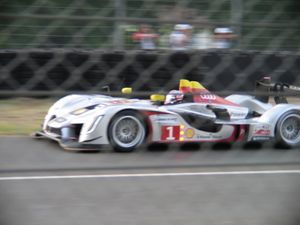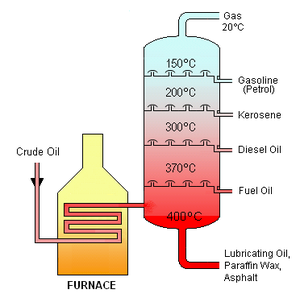محرك رباعي الأشواط

المحرك الرباعي الأشواط إنگليزية: Four-stroke engine في وقتنا الحالي موجود غالبا في السيارات، والشاحنات، والدراجات النارية، والآلات الآخرى. تشير الأشواط الأربعة إلى أربع خطوات في دورة المحرك هي السحب، والضغط، والاحتراق، والعادم، وتنجز هذه الأشواط أثناء دورتين للعمود المرفقي أثناء دورة العمل لمحركات البنزين ومحركات الديزل.
تطوّرات
There are two common types of engines, which are closely related to each other but have major differences in their design and behavior. The earliest of these to be developed is the محرك دورة اوتو الذي طوره في 1876 المهندس نيكولاوس أوگوست اوتو في كولونيا، ألمانيا،[1] after the operation principle described by ألفونس بو ده روشا في 1861. This engine is most often referred to as a petrol engine or gasoline engine, after the fuel that powers it.[2] The second type of four-cycle engine is the محرك ديزل الذي طوره في 1893 المهندس رودولف ديزل، أيضاً من ألمانيا. Diesel created his engine to maximize efficiency which was lacking in the Otto engine. There are several major differences between the Otto cycle engine and the four-cycle diesel engine. ويُصنع محرك ديزل في نسختين، دورة ثنائية ودورة رباعية. Ironically Otto's company Deutz AG produces primarily diesel engines in the modern era.
The Otto cycle is named after the 1876 engine of Nikolaus A. Otto, who built a successful four-cycle engine which was based on the work of جان جوزيف إتيان لنوار.[1] It was the third engine type that Otto developed. It used a sliding flame gateway for ignition of its fuel which was a mixture of illuminating gas and air. After 1884 Otto also developed the magneto allowing the use of an electrical spark for ignition, which had been unreliable on the Lenoir engine.
Today, the internal combustion engine (ICE) is used in motorcycles, automobiles, boats, trucks, aircraft, ships, heavy duty machinery, and in its original intended use as stationary power both for kinetic and electrical power generation. Diesel engines are found in virtually all heavy duty applications such as trucks, ships, locomotives, power generation, and stationary power. Many of these diesel engine are two-cycle with power ratings up to 105,000 hp (78,000 kW).
التاريخ
دورة اوتو
Nikolaus August Otto as a young man was a traveling salesman for a grocery concern. In his travels he encountered the internal combustion engine built in Paris by Belgian expatriate Jean Joseph Etienne Lenoir. In 1860 Lenoir succeeded in creating a double acting engine which ran on illuminating gas at 4% efficiency. The 18 liter Lenoir Engine was able to produce only 2 horsepower. The Lenoir engine ran on the illuminating gas that was made from coal which had been developed in Paris by Philip Lebon.[1][3]
في 1884, Otto's company, now known as Gasmotorenfabrik Deutz (GFD) developed electric ignition and the carburetor.
In 1890, Daimler and Maybach formed a company known as Daimler Motoren Gesellschaft. Today that company is known as Daimler-Benz.
انظر محرك اوتو للمزيد من التفاصيل.
دورة ديزل
 مقالة مفصلة: دورة ديزل
مقالة مفصلة: دورة ديزل
The diesel engine is a technical refinement of the 1876 Otto Cycle engine. تتنافس كل من أودي وپوجو في سباقات التحمل في Le Mans Series بسيارات سباق مزودة بمحركات ديزل. وهم رباعيو الأشواط، رباعيو الصمامات و high revving, turbocharged diesels which dominate largely due to fuel economy and having to make fewer stops.
نبذة من الأسس
تبدأ دورة المحرك من النقطة الميتة العليا (en) حيث يكون المكبس أبعد ما يكون عم محور العمود المرفقي. يشير مصطلح الشوط إلى الانتقال الكامل للمكبس من النقطة الميتة العليا إلى النقطة الميتة السفلى. (اقرأ مقالة النقطة الميتة).
1. شوط السحب: admission في شوط السحب للمكبس يهبط المكبس من النقطة الميتة العليا للأسطوانة إلى أسفل الأسطوانة، مما يقلل من الضغط داخلها. يُدخل مزيجا من الوقود والهواء بالضغط الجوي (أو أكثر) إلى الأسطوانة عبر مدخل السحب. يغلق بعدها صمام أو صمامات السحب.
2. شوط الضغط: compression مع إغلاق صمامات السحب والعادم، يبدأ المكبس بالعودة إلى قمة الأسطوانة ضاغطا مزيج الهواء مع الوقود. يعرف هذا بشوط الضغط.
3. شوط القدرة: ويعرف أيضا بشوط الاحتراقcombustion، عند اقتراب المكيس من النقطة الميتة العليا، يشتعل المزيج، عادة باستخدام شمعة احتراق (في محركات البنزين) أو نتيجة الضغط والحرارة (في دورة الديزل (en) أو محرك الاشتعال بالانضغاط (en)). يؤدي الضغط الكبير المتولد من احتراق المزيج إلى إعادة المكبس إلى النقطة الميتة السفلى مدفوعا بقوة هائلة. يعرف هذا الشوط بشوط القدرة، وهو المصدر الأساسي لعزم المحرك وقدرته.
4. شوط العادم: expansion & exhaust أثناء شوط العادم، يعود المكبس ثانية إلى النقطة الميتة العليا ويفتح أثناءها صمام العادم. يدفع المكبس أمامه نواتج المزيج المحترقة ويخرجها من الأسطوانة عبر صمام أو صمامات العادم. ويبين الشكل (1) الأطوار الأربعة في دورة روشاس التي تبدأ من النقطة a إلى b إلى c إلى d إلى e وتكتمل الدورة بالعودة إلى النقطة a.
تجدر الإشارة إلى أن نقل فكرة روشاس إلى حيز التطبيق العملي جاء نتيجة مساهمة آخرين يُذكر منهم الألماني نيقولاوس أوتو N.Otto والفرنسي إيتيان لينوار E.Lenoir، اللذان جعلا من محرك الاحتراق الداخلي ذي الأطوار أو الأشواط الأربعة، محركاً واسع الانتشار على نطاق عالمي.[4]
التحليل الثرموديناميكي

exhaust (D) stroke.
The thermodynamic analysis of the actual four-stroke or two-stroke cycles is not a simple task. However, the analysis can be simplified significantly if air standard assumptions[5] are utilized. The resulting cycle, which closely resembles the actual operating conditions, is the Otto cycle.
متطلبات الاوكتان
Fuel octane rating
محركات اوتو
During the compression cycle of a compressed charge internal combustion engine the temperature of the fuel air mixture rises as described by Charles Law solely due to the compression of the gases. The temperature rise is several hundreds of degrees.
مبادئ التصميم والهندسة
حدود مُخرَج الطاقة
توازن الطاقة



Starting position, intake stroke, and compression stroke.



Ignition of fuel, power stroke, and exhaust stroke.
انظر أيضاً
مراجع
- ^ أ ب ت [1], Nikolaus August Otto: Inventor Of The Internal Combustion Engine.
- ^ Brittanica, Britannica Gasoline Engine.
- ^ [2], NA Otto Museum.
- ^ أحمد محمود حصري. "دورة روشاس". الموسوعة العربية.
- ^ Best Place for Engineering and Technology, Air Standard Assumptions.
مصادر
- Hardenberg, Horst O. (1999). The Middle Ages of the Internal combustion Engine. Society of Automotive Engineers (SAE). ISBN 9780768003918.
- scienceworld.wolfram.com/physics/OttoCycle.html
- Cengel et. al., Yunus A. (2009). Thermodynamics: An Engineering Approach. N.p. McGraw Hill. ISBN 9787121084782.
- Benson, Tom (11 July 2008). "4 Stroke Internal Combustion Engine". p. National Aeronautics and Space Administration. Retrieved 5 May 2011.
وصلات خارجية
- U.S. Patent 194٬047
- Detailed Engine Animations
- How Car Engines Work
- Animated Engines, four stroke another explanation of the four-stroke engine
- CDX eTextbook – some videos of car components in action
- Video from inside a four-stroke engine cylinder.






